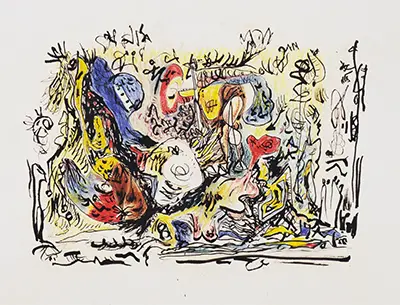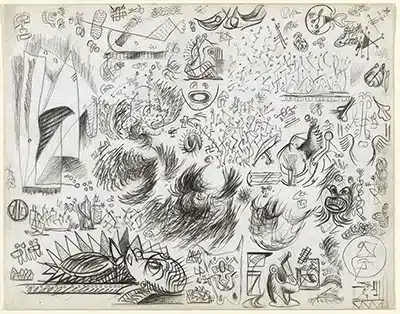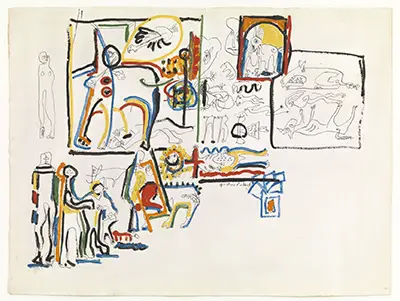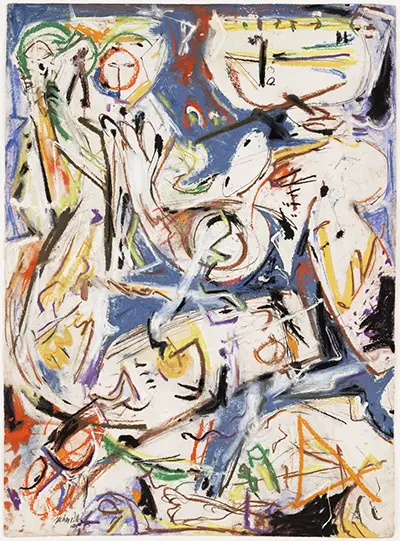Jackson Pollock is one of the most essential American artists who ever lived. Jackson Pollock and his artistic ability have always been debated, raising questions about what defines true artistic talent.
An iconic American artist, Jackson Pollock is widely recognized for his abstract expressionist paintings characterized by intricate drips and splatters. However, the question remains: Could Jackson Pollock draw? Or did Jackson Pollock have any real skill as an artist, or was he just able to splash and spill paint?
Table of Contents
- Jackson Pollock’s Art Education
- The Influence Of Education And Exploration On Jackson Pollocks Style
- Jackson Pollock And Mastering the Fundamentals Of Drawing Skills
- The Influence Of Drawing In Jackson Pollock’s Iconic Style
- Jackson Pollock Understood Drawing As A Language Of Expression
- Jackson Pollock’s Use Of A Variety Of Drawing Tools
- The Impact and Appeal of Jackson Pollock: 10 Reasons Behind His Artistic Significance
- Frequently Asked Questions
- Related Questions
Jackson Pollock’s Art Education
Jackson Pollock’s artistic education began with his enrollment at the Art Students League of New York in 1929. Under the guidance of influential teachers such as Thomas Hart Benton, Pollock honed his technical skills and immersed himself in the rich artistic milieu of New York City.
Drawing was the fundamental building block of his artistic development, allowing him to understand form, perspective, and composition. Through countless hours of practice, Pollock gained a deep understanding of the principles of drawing, which later became instrumental in his innovative approach to art.
The Influence Of Education And Exploration On Jackson Pollocks Style
One of the aspects of Jackson Pollock is that he broke with traditions. Artists often adhered to established techniques and mediums in earlier centuries, perpetuating traditional artistic practices.
However, the mid-20th century, when Pollock was an artist, we witnessed a shift in the art world, with educational institutions fostering a spirit of exploration and artistic freedom. Aspiring artists were exposed to diverse materials during their studies, encouraging them to embrace experimentation.

This newfound freedom liberated artists from the constraints of tradition, enabling them to forge their creative paths. Jackson Pollock was a product of this environment, and his willingness to explore different mediums was pivotal in his artistic development.
Jackson Pollock And Mastering the Fundamentals Of Drawing Skills
Drawing skills are the cornerstone of artistic practice, enabling artists to translate their ideas and observations onto paper or canvas. For Pollock, his proficiency in drawing was a crucial foundation upon which he built his unique style.

Before venturing into his renowned drip paintings, Pollock possessed a solid command of line, shape, and proportion, acquired through years of disciplined study. This technical mastery empowered him to explore new artistic territories and expand the boundaries of traditional drawing.
The Influence Of Drawing In Jackson Pollock’s Iconic Style
While Pollock’s later works are predominantly associated with his iconic drip paintings, it is crucial to recognize the influence of drawing on his artistic approach. His drawings acted as visual experiments, allowing him to explore movement, rhythm, and spontaneity.

Pollock’s command of line and gesture, honed through years of drawing, informed his fluid and dynamic painting technique. His drawing skills derive from the physicality of his brushwork, the intricate interplay of lines and forms, and the sense of energy in his compositions.
Jackson Pollock Understood Drawing As A Language Of Expression
Jackson Pollock understood that drawing was essential for art; he knew drawing was also a form of expression.
For an artist, drawing goes beyond the ability to depict realistic representations; it serves as a means of personal expression and communication. Pollock’s drawings, created both during his academic years and throughout his career, provide insights into his artistic language.
They reveal his experimentation with different techniques, compositions, and mark-making. Pollock explored and refined his visual vocabulary through drawing, while developing his unique artistic voice.
Listen To Our Podcast About Decoding Jackson Pollock’s Art: Unraveling The Mastery Of Abstract Expressionism,
below or by clicking here.

Jackson Pollock’s Use Of A Variety Of Drawing Tools
When we examine Jackson Pollock’s drawings, the first thing that catches the eye when analyzing a selection of Pollock’s drawings is the sheer range of drawing tools he utilized. Pollock’s artistic arsenal consisted of various materials, extending beyond standard pencils and charcoal.
He was known to use Indian ink, gouache, and other alternative mediums that found their way into his repertoire, showcasing his desire to experiment and push boundaries. This inclination towards mixed media was not exclusive to Pollock but a characteristic of many modern artists during the mid to late 20th century.

With increased access to a wide array of art materials facilitated by art manufacturers, artists like Pollock could explore new avenues of expression. And Jackson Pollock, in his drawings, showed us that he used various drawing tools.
.Jackson Pollock’s artistic education and mastery of drawing skills were pivotal in shaping his innovative approach to art. Through disciplined study and experimentation, Pollock developed a deep understanding of the fundamentals of drawing, which served as the foundation for his groundbreaking style.
Drawing acted as a language of expression, enabling him to communicate his ideas and emotions. While Pollock’s work transcends traditional notions of drawing, his command of line, form, and composition, acquired through his artistic education, played a significant role in his abstract expressionist paintings.
The Impact and Appeal of Jackson Pollock: 10 Reasons Behind His Artistic Significance
- Innovator of Abstract Expressionism: Pollock pioneered the Abstract Expressionist movement, radically shifting the landscape of modern art with his unique style.
- Creator of Drip Painting Technique: He is famed for his drip painting technique, a revolutionary method that involved dripping and splattering paint onto a canvas, creating energetic, abstract compositions.
- Breaking Traditional Boundaries: Pollock challenged traditional notions of painting by placing his canvas on the floor and painting from all angles, breaking free from the constraints of the easel and brush.
- Expression of Subconscious Mind: His artworks are often interpreted as expressions of the subconscious mind, inviting viewers to explore deeper psychological meanings.
- Influence on Future Art Movements: Pollock’s work significantly influenced later art movements, such as action painting and performance art, due to his dynamic and physically engaging painting process.
- Intensity and Energy: His paintings’ intensity and raw energy create a powerful visual experience, captivating audiences with their motion and emotion.
- Cultural Icon: Pollock became an icon of American art, symbolizing the post-World War II artistic boom in the United States and the rise of New York as a center of the art world.
- Innovative Use of Color and Form: His use of color and form was innovative, creating complex and captivating visual experiences that challenge traditional art perspectives.
- Personal and Emotional Depth: His art is deeply personal, reflecting his own struggles and emotions, which resonates with many viewers on an emotional level.
- Enduring Influence and Popularity: Decades after his passing, Pollock’s work continues to be celebrated and studied, with his distinctive style maintaining a significant influence in the art world.
Jackson Pollock’s importance in the art world stems from his groundbreaking techniques, emotional depth, and the lasting impact he made on abstract art. His legacy inspires and fascinates art enthusiasts and the general public.
Anita Louise Art is dedicated to art education, great artists, and inspiring others to find and create their art. We love art that uplifts and inspires. #ArtToMakeYouSmile! #ArtToMakeYouHappy!
If you want to see any of my art, you can find out more by clicking here. If you are interested in what inspires me and my paintings, you can discover more by clicking here.
We have a free newsletter and would love you to be part of our community; you can subscribe to the newsletter by clicking here. I would be happy to talk to you if you have any questions. You can reach me, Anita, by clicking here.
Subscribe to our Anita Louise Art YouTube Channel with great videos and information by clicking here.
Join us for our podcast “5 Minutes With Art.” Spend just 5 minutes a week with us to discover and learn about great art and artists. You can find out more about our podcast by clicking here.
Frequently Asked Questions
Could Jackson Pollock draw?
Yes, Jackson Pollock had the ability to draw, but his artistic style was focused on abstract expressionism, which often involved spontaneous and gestural painting techniques.
Was Jackson Pollock’s art just about splashing and spilling paint?
While Jackson Pollock’s signature technique involved dripping and splattering paint, his work goes beyond that. His art was a complex interplay of rhythm, movement, and emotion, and it often contained deliberate and calculated elements.
What is abstract expressionism?
Abstract expressionism is an art movement characterized by non-representational forms and a focus on conveying emotion, mood, and energy through spontaneous and gestural brushwork.
Did Jackson Pollock receive any formal artistic training?
Yes, Jackson Pollock did receive formal training at various art schools and under different teachers. However, he later moved away from traditional techniques towards his distinctive style.
What is the significance of Jackson Pollock’s artistic contributions?
Jackson Pollock played a crucial role in redefining modern art by pushing the boundaries of artistic expression and challenging conventional techniques.
How did Jackson Pollock’s artistic process work?
Pollock’s process often involved laying a canvas on the ground and then dripping or pouring paint onto it, allowing the paint to interact organically. This method was a way of connecting his emotions directly to the canvas.
Did Jackson Pollock’s work receive critical acclaim during his lifetime?
Jackson Pollock faced a mix of both acclaim and criticism during his lifetime. His work was polarizing, with some praising his innovation while others questioned his departure from traditional artistic forms.
What influence did Jackson Pollock have on the art world?
Jackson Pollock’s work contributed significantly to the development of abstract expressionism and had a lasting impact on subsequent generations of artists, influencing their approach to creativity and artistic expression.
How do art experts analyze Jackson Pollock’s paintings?
Art experts analyze Pollock’s paintings through various lenses, examining his brushwork, color choices, compositional elements, and emotional resonance to gain deeper insights into his artistic intentions.
Related Questions
How Much Is The Jackson Pollock Painting Worth In The Movie “The Accountant”?
We do not know precisely how much the Jackson Pollock Free Form painting is worth, but we know that it is owned by the Museum of Modern Art in New York City, and the painting in the movie The Accountant is a reproduction or copy. We know that similar Jackson Pollock paintings have sold for over $100 million. So we know that Jackson Pollock’s paintings are precious in today’s art market.
What Makes Jackson Pollock’s Art So Valuable?
Jackson Pollock was a brilliant and creative artist who was not afraid to try new techniques with art. He is known for being a founder of Abstract Expressionism and the gestural technique, also known as action painting. He never saw much success in his lifetime, but today his painting fetch millions of dollars and are considered extremely valuable.
By clicking here, you can discover more by reading What Makes Jackson Pollock’s Art So Valuable?.
Understanding Jackson Pollock’s Paintings And His Art
Understanding that Jackson Pollock has absolute honesty in his paintings, he shows us his great technique and ability to use paint in ways that have never been used before. His paintings are very dimensional, so when you look at them in one way but get up close, you may see another way. He’s not trying to fool us in any way but just saying here, view it as you want to see it.
By clicking here, you can learn more by reading Understanding Jackson Pollock’s Paintings And His Art.

